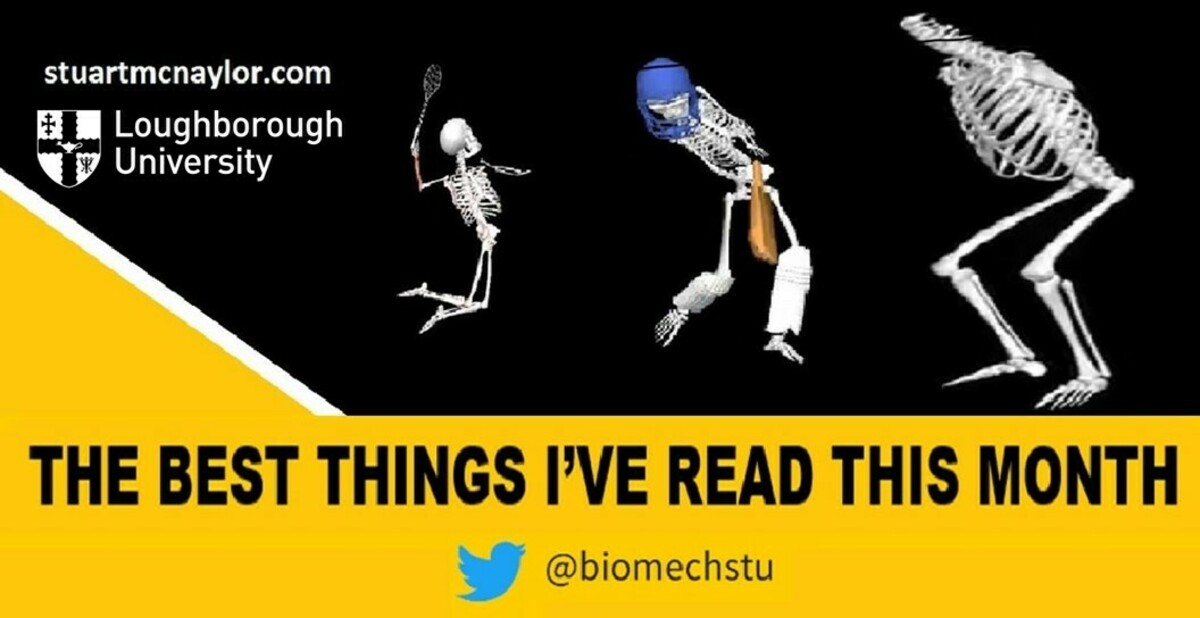
Welcome to my monthly update.
I’m trying something different this month, summarising the best things I read all month.
But first, a quick recap of some of the things I’ve been up to…
Ten Common Statistical Mistakes
This blog post is a visual summary of the eLife article “Ten common statistical mistakes to watch out for when writing or reviewing a manuscript”. The post is also available as a Twitter thread or 5 min video summary (below):
What Are the Common Statistical Mistakes?
- Absence of an adequate control condition/group
- Interpreting comparisons between two effects without directly comparing them
- Spurious correlations
- Inflating the units of analysis
- Correlation and causation
- Use of small samples
- Circular analysis
- Flexibility of analysis
- Failing to correct for multiple comparisons 10 Over-interpreting non-significant results
ISBS
I am currently standing for election to the International Society of Biomechanics in Sports (ISBS) Board of Directors. This would allow me to continue my passion for engaging the wider audience in all things sports biomechanics, advancing my previous work on the Publications Committee and Online Symposia Organising Committees, as Social Media Editor for the society’s journal, and in organising the Sports Biomechanics Lecture Series .
All ISBS members should have received an email regarding voting procedures (voting open until 6th May). Please get in touch if you have any questions or wish to discuss future directions for the society.
What Have I Been Reading?
Now for the main part of the newsletter…
Comedic Papers
The month began with April Fools’ Day and a couple of humerous articles. Firstly, this proposed method to streamline p-hacking (a random generator of p-values < 0.05) and then this paper claiming to have generated all possible hypotheses (and requesting citations in all future hypothesis testing studies).
Periodisation for Mental Health
John Harry’s ‘Fun Friday’ blog post applied the training concept of periodisation to academic workload management. I hadn’t thought about it this way very much but it seems to be a more formal representation of the approach I’ve adopted recently - periodisation sums it up brilliantly.
Search Engine Optimisation for Papers
I’ve done some reading around search engine optimisation recently, mostly for blog posts or YouTube videos - but then I discovered this article on how to write a scientific article for Google / Google Scholar to read and prioritise. The main take-away points were that the main concept (the one people should search for) should be the first part of the title, you should include “X is [simple definition]” in the abstract, and your first image may be used as a preview. I guess there is a trade-off between titles that will receive the most attention in the short-term (possibly including puns or eye-catching titles) and those that will appear on searches for years to come. Related to this, my Twitter poll revealed that most people use the topic as their title even though they themselves are most likely to click on and open articles with the answer/findings as the title. Apparently hyphens in titles can also reduce citations, although I’m hoping that bug has since been fixed (for the sake of my surname if nothing else!).
What is a Markov Chain?
This Twitter thread explains the concept of Markov Chains in an easy-to-follow step-by-step approach, with the example of two participants tossing coins and racing to their respective goal outcomes.
The Science of Scientific Writing
This post in American Scientist provides a series of rules for scientific writing, giving examples and detailed explanations of each. Great importance is placed upon the ordering of information within a sentence. For more on scientific writing, you can check out Kristin Sainani’s lecture as part of the Sports Biomechanics Lecture Series .
Pink Noise?
This one’s a listen rather than a read, but I really enjoyed Rob Gray’s Perception & Action Podcast episode on white/brown/pink noise and why the standard deviation might not reflect variability in motor control. It’s a must-listen for anybody researching or interested in movement variability.
Machine Learning
A useful editorial in Sports Biomechanics by Richter et al. on the challenges and opportunities of machine learning in sports science. This provides a useful overview for anybody reading machine learning articles and wanting to understand or critically evaluate the methods used.
Sample size estimation for biomechanical waveforms
A really useful paper (and Twitter thread ) for anybody conducting 1D biomechanical analyses. The explanatory diagrams throughout are a big help too. Interestingly, the 1D sample sizes required were always greater than for 0D (discrete values, peaks, etc.) analyses (from n + 1 to more than n + 20). For more on power analysis or 1D analysis you can check out my recent tutorial videos, or Todd Pataky’s continuous biomechanical data analysis lecture .
Inverse Dynamics
This month was one year since Bill Baltzopoulos’ excellent lecture on inverse dynamics terminology and mechanical misconceptions. This reminded me of the related paper in which he explains the difference between an ‘Actual Forces’ approach and a ‘Resultant Moments’ approach to inverse dynamics, with their corresponding terminology and implications.
Thank You
That’s all for this month. If you would like to share or recommend the newsletter then you can share this link .
Let me know if you liked the “thing’s I’ve read” approach as i may try this again in future months.
Take care, and thank you for reading.
Stuart